Walking into Carolee Schneemann’s room in east London, my eyes are immediately drawn to a remarkable orange mask propped against an ice bucket. I study its eerie feline features for a moment before the penny drops: it’s a golden lion. Four days before we meet, Schneemann had picked up the Venice Biennale’s Golden Lion for Lifetime Achievement, recognition for six decades of innovation and provocation across an array of media. ‘Friends bought me that,’ Schneemann explains, noticing my interest in the Venetian mask, ‘to balance my annoyance with the Golden Lion statue.’ Apparently, one of contemporary art’s most prestigious awards looks like ‘a hood ornament for a Porsche’.
The honour in Venice is not the only sign that Schneemann’s diverse and frequently audacious art is now enjoying an increasingly central position after long periods of marginalisation. ‘More Wrong Things’, a solo exhibition at Hales Gallery in London (20 May–24 June) displaying a small group of works from the 1980s to the early 2000s, coincided with the opening of ‘Kinetic Painting’ at the Museum für Moderne Kunst in Frankfurt ( until 24 September), a vast survey of Schneemann’s career. This rich and dramatic retrospective, which features paintings, assemblages, photographs, films, multimedia installations, and performance documentation, first appeared at the Museum der Moderne in Salzburg in 2015, and will travel to MoMA PS1 in New York this autumn (22 October–1 February 2018).
Yet, as her mocking of the Golden Lion statue indicates, the 77-year-old Schneemann is taking the recent attention with humour and a sense of ambivalence. Sat bolt upright and with a sharp, engaged focus – it’s easy to see why the writer and activist Lucy Lippard once claimed that Schneemann has ‘a regal poise’ – she seems rather torn, and certainly not vindicated, when reflecting upon the acclaim her work is currently receiving. ‘The Golden Lion is a fantastic symbolic appreciation. It’s wonderful. But no one cared about this work until relatively recently, so everything for me has a huge question mark around it.’ When I ask Schneemann what she considers her lifetime achievement to be, her answer is brutally honest: ‘Surviving the neglect of my culture.’
Schneemann was born in 1939 and grew up in rural Pennsylvania. ‘I spent most of my childhood hiding in woods and burrowing in leaves’ she recalls, adding, ‘I’m not comfortable in the city as a base.’ Since 1964, she has lived on the edge of a small village 80 miles north of New York City in an ‘incredible, magical’ 18th-century stone house.
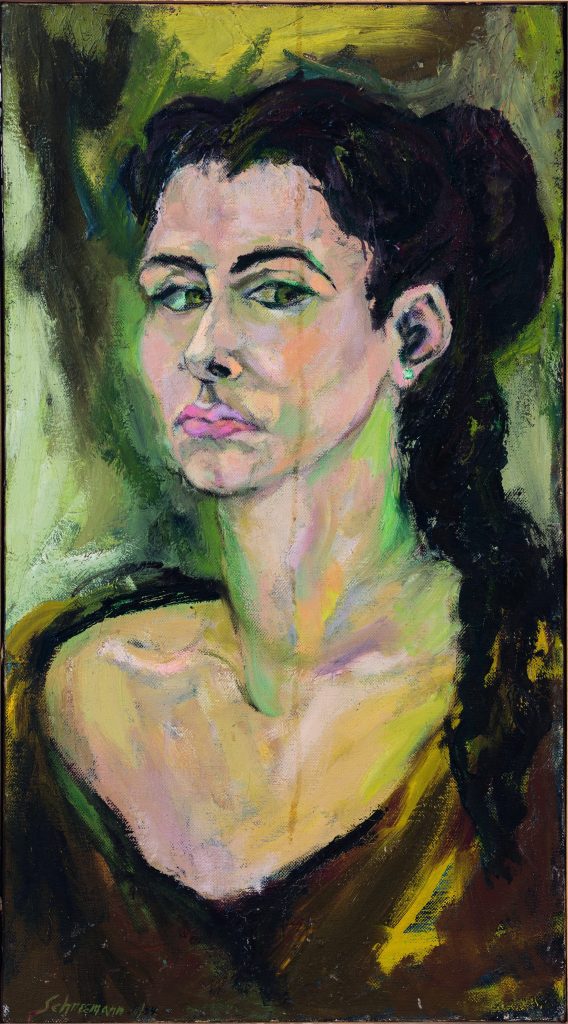
Self-portrait (1955), Carolee Schneemann. Photo: Axel Schneider; courtesy Carolee Schneemann and P.P.O.W., New York, Galerie Lelong & Co., New York, Hales Gallery, London, and V.G. Bild Kunst, Bonn; © Carolee Schneemann
From the outset, Schneemann’s approach to art was bold and committed. As she notes in her diaries, ‘I began to draw before I could speak and never stopped drawing.’ She discovered Cézanne as a teenager and felt an instant connection. There are hints of the French artist’s work, as well as clear evidence of adolescent self-confidence, in Schneemann’s Self-portrait (1955), the oil painting that greets visitors to the Frankfurt retrospective. She depicts herself surrounded by earthy browns and greens with touches of marine blue. Stern eyes that refuse easy confrontation with a viewer’s gaze are matched by a strikingly arched pose and a wide exposed neckline. It’s a portrait of the artist as a powerful young woman. Although she has doubts about the work’s quality (‘it’s very stiff’), Schneemann is engaged by its subject’s demeanour. ‘It looks very fierce. I’m not close to that self so much any more, but I’m interested in how very ferocious she looks. She’s like: Don’t mess with me. I’m on this canvas and I’m not budging.’
The ferocity of the painting can be seen as a defiant reaction to the constant sexism Schneemann encountered. A literature teacher once told her she could write on Proust, Mann or Joyce, but not on Woolf, despite the fact that The Waves ‘completely, utterly transformed everything I thought was possible.’ A philosophy professor urged her to explore Sartre rather than de Beauvoir, with the explanation: ‘Why honey, do you want to do a paper on the mistress? Why don’t you do the master?’ Schneemann says her early life was shaped by a ‘double knowledge’: ‘You’re just a girl, don’t expect to do anything. Or, if you do what you want, don’t expect us to care about it.’
Despite her father’s belief that women needn’t go to university, in 1955 Schneemann gained a full scholarship to Bard College in New York State. ‘Most of my contemporaries at art school were very macho, very competitive,’ she says. ‘They had a sense of righteous intention which enabled them to steal my paintbrushes, steal my paints and say, “We need this more than you do.” Then they’d ask me to sew buttons on their broken jackets.’ Her work from the late 1950s is filled with allusions to a male-dominated tradition of painting – from Renaissance figures, such as Pontormo, to the era’s dominant Abstract Expressionists, such as Jackson Pollock. Schneemann, though, would begin to use the term ‘art istorical’ in her writings, as a gesture towards removing gender bias. In a 1975 essay titled ‘Woman in the Year 2000’, she wrote, ‘By the year 2000 no young woman artist will meet the determined resistance and constant undermining which I endured as a student.’ When I ask her to reflect on those ambitions now, her response is positive. ‘That was a wishful fantasy and it’s arrived, it really has.’ However, while she is ‘thrilled’ at the progress made in gender equality since her own student days, she’s keen to stress that ‘it’s so precarious,’ especially in the context of the open misogyny that marked last year’s US Presidential election.
Bard presented additional problems. Although Schneemann eventually graduated from the college in 1959, she was earlier expelled for ‘moral turpitude’. She claims she has still never discovered the exact reasons for her expulsion – ‘I was hoping it would be like moral turpentine, the painterly problem,’ she jokes – but assumes it was related to the nude self-portraits she was making. The decision had sunnier consequences. Schneemann transferred to the School of Painting and Sculpture at Columbia University in New York, where she met the composer James Tenney. They married in 1956 and remained together until the late 1960s.
Schneemann’s close engagement with New York’s thrilling downtown scene also developed at this time. She met figures such as John Cage, Joseph Cornell, Maya Deren, and Yvonne Rainer. The film-maker Stan Brakhage became a close friend, while Marcel Duchamp asked her to recite place names from Illinois, where Schneemann had completed a Masters degree after Bard. When I ask her to reflect on the 1960s in New York, and how it’s mythologised in contemporary culture, she is characteristically nuanced in her response. ‘It’s such a mix. I enjoy thinking about it and talking about it. But it was also a horrific time. It was a time of assassination, the constant nightmare of bombarding Vietnam. It was a time of underlying violence that also had this great joy and excitement and vibrancy.’
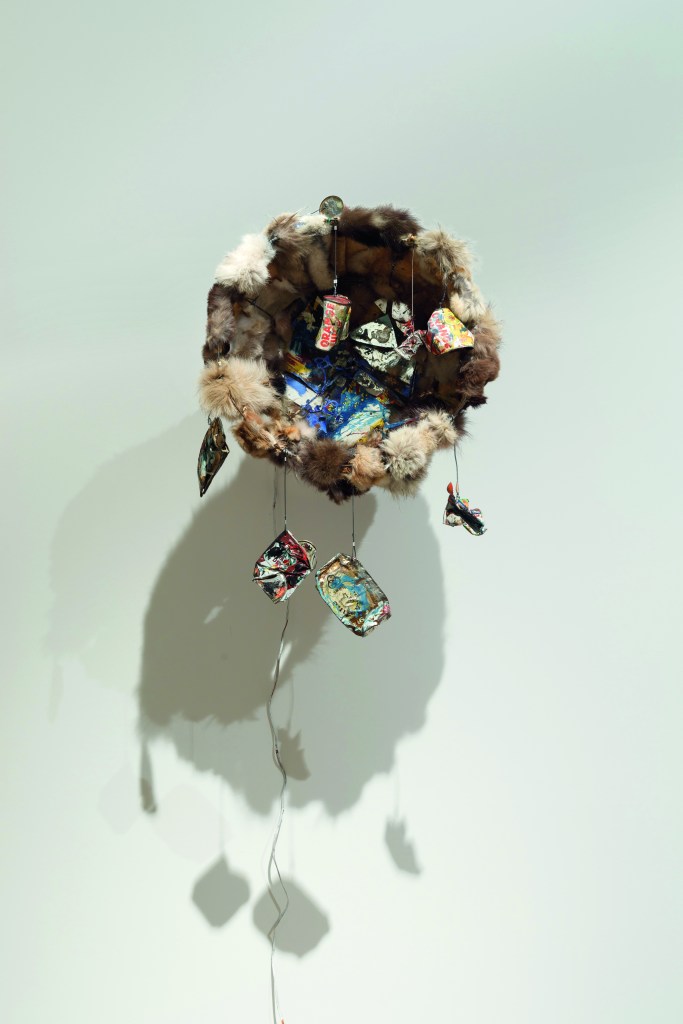
Fur Wheel (1962), Carolee Schneemann. Photo: Axel Schneider; courtesy Carolee Schneemann and P.P.O.W., New York, Galerie Lelong & Co., New York, Hales Gallery, London, and V.G. Bild Kunst, Bonn; © Carolee Schneemann
In the 1960s Schneemann’s practice broadened in multiple, ambitious ways. Her paintings increasingly moved beyond the canvas, incorporating found objects and images, motorised elements, and burnt remains. Fur Wheel (1962) is a rotating arrangement of clanking tin cans and shards of glass mounted on a lampshade, while Four Fur Cutting Boards (1963) is a semi-circular grouping of brightly painted wooden planks with a hubcap and two umbrellas affixed. Pharaoh’s Daughter (1966) is a much smaller painted wooden box filled with slides, light bulbs and tiny metallic objects – a darker cousin to Cornell’s meticulous creations.
Schneemann’s first visit to the Venice Biennale was much less celebrated than her recent trip. It was in 1964, the year that the Grand Prize was awarded to Robert Rauschenberg, provoking debates about the emergence of Pop art and the influence of American culture. Schneemann explains, ‘Everyone said my work was not really worth thinking about, that it looked like a bad version of Rauschenberg.’ Fifty years on, these assemblages and boxes maintain a potent combination of the era’s violence and vibrancy.
Film became a core part of her practice in this period. Perhaps the most compelling demonstration of this, and a work that remains one of Schneemann’s most moving and intimate, is Fuses (1964–67). Shot in the home she occupies to this day, Fuses is a complex attempt ‘to film the erotic life’ that – inevitably, depressingly – generated glib accusations of pornography. It consists of nearly 30 minutes of silent 16mm colour footage that shows the artist and James Tenney in a sequence of sexual acts seen from the perspective of their cat, Kitch. The film material itself was deliberately disfigured with fire and acid, while paint and collage elements add further interruptions to the flow of images. It’s an extraordinarily personal and precious film, a fluid collection of moments and memories that avoids taking a sustained, singular approach to a sexual relationship. Of the film-making process Schneemann says, ‘I love editing. I love having the protrusion of images that have to be examined and selected.’
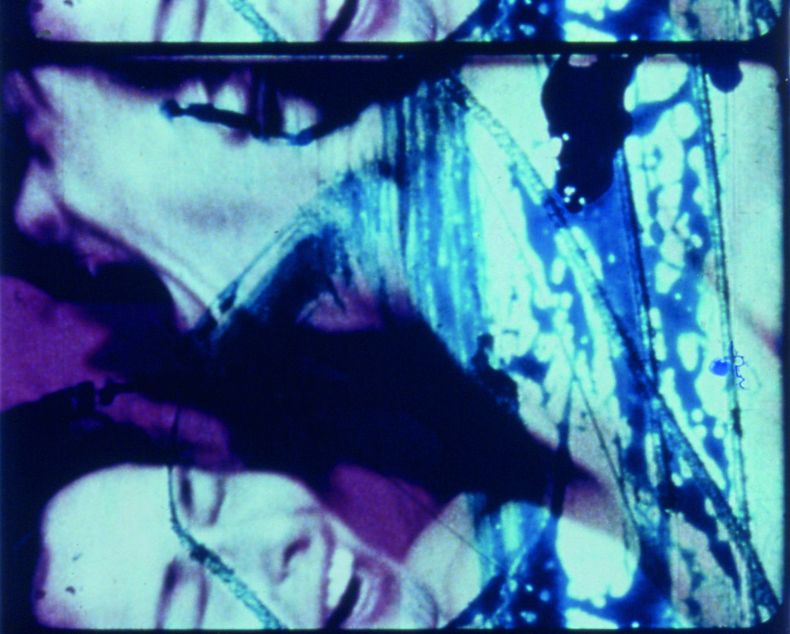
Fuses (film still), (1964–67), Carolee Schneemann. Courtesy Carolee Schneemann and P.P.OW, New York, Galerie Lelong & Co., New York, Hales Gallery, London; © Carolee Schneemann
The ambitions of the project stretched far beyond formal experimentation. Fuses was a challenge to traditional perspectives on sex and intimacy, including those offered by Brakhage, who shot Schneemann and Tenney for two of his own films. ‘Why is it that men are never the vulnerable subjects?’ Schneemann asks. ‘They’re always the director and in control.’ Anticipating the vital debates about the ‘male gaze’ that would dominate film theory in the 1970s, Schneemann wanted to resist objectifying or fetishising the female body. She was especially interested in ‘the salutary potential of pleasure and shared pleasure’. ‘Genital pleasure is just so interesting and so marvellous,’ she says. At the time, she tells me, Schneemann believed that Fuses ‘should go in every lunch room in high schools’. ‘Fat chance!’ she now admits, though its legacy seems secure, nonetheless. The critic Ara Osterweil has described Fuses as an ‘avant-garde, feminist classic’ and ‘one of the most important cinematic documents of the sex act’.
A similar interest in bodies, pleasure, and gender politics runs throughout the groundbreaking performances Schneemann created in the 1960s and ’70s. Two works in particular, Meat Joy (1964) and Interior Scroll (1975–77), have become canonical entries in the history of performance art, to the extent that they often overshadow the broader scope of the artist’s achievements. Meat Joy was performed in Paris, London, and New York. It combined carefully choreographed lighting (shifting from strong illumination to moments of darkness) and sound elements (including tapes of traffic noise and pop songs) with messy, playful interactions between a group of men and women, many in their underwear. Famously, materials ranging from raw fish and sausages to paint and plastic sheeting are introduced into the mix, generating a dream-inspired, erotically charged event.
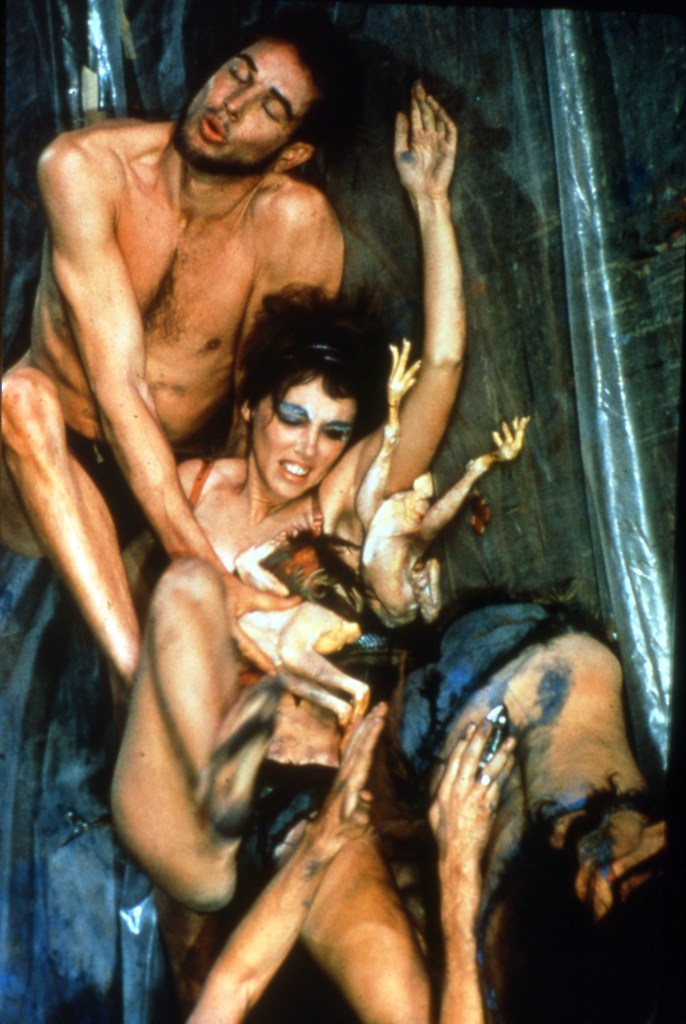
Meat Joy (1964), Carolee Schneeman, video still of the documentation of the performance at the Judson Dance Theater, Judson Memorial Church, New York, 16–18 November, 1964. Courtesy C. Schneemann and P.P.OW. Gallery, New York; photo: Al Giese; courtesy Electronic Arts Intermix (EAI); © Carolee Schneemann; © Bildrecht, Wien, 2015; © Generali Foundation Collection – permanent loan to the Museum der Moderne Salzburg
Interior Scroll, by contrast, was a solo performance first given by Schneemann in Long Island, New York in 1975 (to an audience of mainly female artists) and later, with slight variations, at a film festival in Telluride, Colorado in 1977. The work involved her climbing on to a table, applying paint (and, in Telluride, mud) to her near-naked body, and then reading her own feminist texts from a narrow piece of paper that she slowly pulled from her vagina.
Once again, critical responses to these works have been varied and often hostile. Of particular significance to Schneemann was the rejection of her work by many feminist critics in the 1970s and 1980s. ‘Their conviction was that my work was playing into the worst traditions of male hands by using my body. I was very unhappy about that. I could accept being rejected by traditional male erotic expectations, but there were so many strict feminist movements that I couldn’t join.’
Schneemann’s position in relation to performance art is not as clear-cut as it seems, either. Much of the coverage of her Golden Lion award has suggested that it represents a triumph for performance art as a whole, given her pioneering impact on the field and the rapid rise in its public appeal and institutional status in recent years. Yet, Schneemann herself has concerns about how the notion of ‘performance’ has evolved. ‘I think it’s a demeaning term. It’s reductive. The language is stripped of its real stress and tension. If somebody lies in the street throwing up, someone will say “performance art” now. Whereas the originators of what became performance art, the visionary artists such as Rauschenberg, Claes Oldenburg, Jim Dine, and Robert Whitman – they’ve never been called “performance artists”. They’re artists, they’re sculptors, they’re painters. They’re not entertainers dancing on their tiptoes and throwing their clothes off.’ This stance offers a useful context for considering Schneemann’s constant insistence that she is a painter, though hers is clearly an expanded notion of the term.
The debates about Schneemann’s relationship to performance and to feminist theory have tended to occlude discussion of the artist’s broader political engagement. In particular, the focus on pleasure, especially sexual pleasure, in her work has obscured its dark double: an interest in violence and conflict that has been especially apparent since the early 1980s. As she explains, ‘Most of my work for the past 25 years has been concerned with the movement between an almost domestic harmony and eroticism in contradiction with sustained military violence and the destruction of our historic cultures.’ A precursor to her later, focus on violence can be seen in the anti-war film Viet-Flakes (1965), and subsequent work has often examined the impact of conflict in the Middle East.
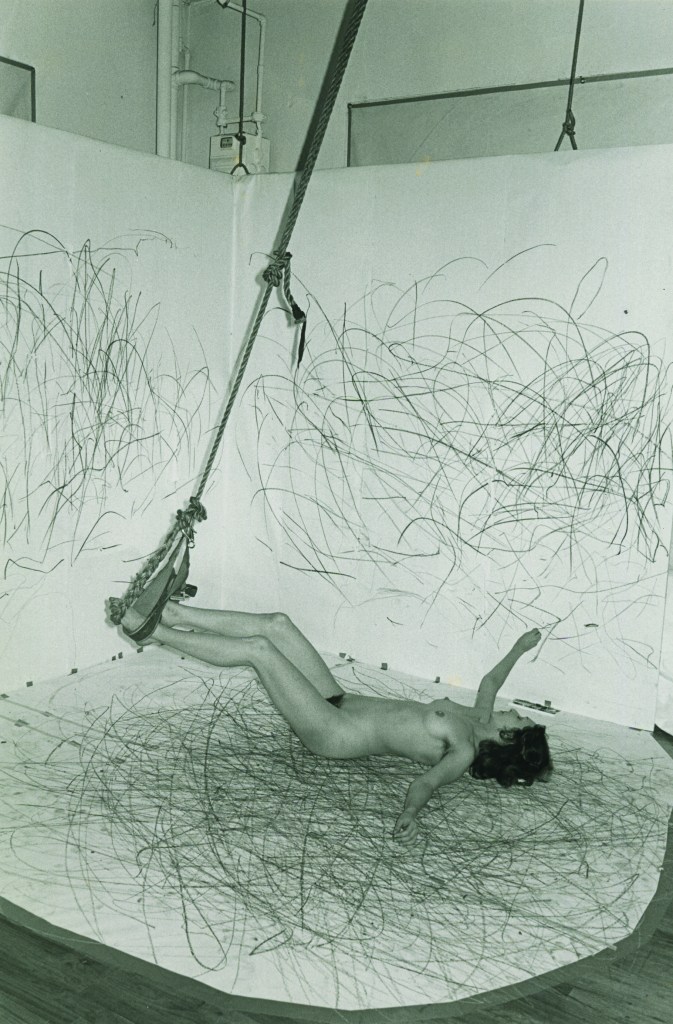
Up to and Including her Limits (1973–76), Carolee Schneemann. Documentation of the performance at the Kitchen, New York, February 1976. Courtesy Carolee Schneemann and Staatliche Museen zu Berlin, P.P.O.W. Gallery, New York, Galerie Lelong & Co., New York, Hales Gallery, London, and V.G. Bild Kunst, Bonn; © Carolee Schneemann
The recent Hales Gallery show highlighted this facet of Schneemann’s practice. It featured a series of Dust Paintings, made in the mid 1980s, which incorporate photographs of war damage in Lebanon with ash, shards of glass, and the remains of computer equipment. Also on display were Terminal Velocity (2001–05), a gridded sequence of prints showing figures falling from the World Trade Center during the 9/11 attacks, and the sprawling installation More Wrong Things (2000), which consists of 18 monitors, suspended from the ceiling so that their wires form a twisted electronic web, that bring together footage from the artist’s personal archive with public tragedies. ‘Violence is the underbelly of everything that privileges us,’ Schneemann says. ‘Why is this more taboo and secret than sexual pleasure?’
The violence and tragedy of contemporary politics framed her recent experience in Venice, and perhaps offers a further context for her conflicted feelings towards the lifetime achievement award. ‘When I was anticipating the Golden Lion, the refugees washed up on the shores of Italy and Greece were given golden wraps. Struggling people all wrapped in this golden foil.’
If Schneemann’s career has involved constantly thinking and rethinking her approach to images, one of the surprising pleasures of the ‘Kinetic Painting’ survey is its range of written material and documentation. Throughout her life, Schneemann has maintained an intense correspondence with the likes of Brakhage, Cornell, and Rainer as well as influential cultural figures such as Allan Kaprow, Charles Olson, and Agnès Varda. Diaries, scrapbooks, notes, and cue cards all testify to the centrality of writing in her life.
Given the richness of these texts, I ask Schneemann if she’s still such a prolific writer. She directs me to a thick red leather diary by the side of her bed. It’s filled with detailed observations on a range of topics. ‘One of my art dealers said, “Don’t you get tired of yourself?” And I said, “But all this rare, amazing sunlight and pieces of glass and somebody’s wonderful mouth. I don’t get tired of it all, ever.”’ Schneemann has been keeping a daily diary since she was a small child, a habit that seems set in stone, though perhaps it masks some persistent fears, too. ‘It’s a clarification of everything that’s in motion. I have to grab a bit, I have to hold on to some of it, because it’s all so interesting and it’s all going away, always.’
‘Kinetic Painting’ is at the Museum für Moderne Kunst in Frankfurt until 24 September.
From the July/August issue of Apollo. Preview and subscribe here.
Unlimited access from just $16 every 3 months
Subscribe to get unlimited and exclusive access to the top art stories, interviews and exhibition reviews.

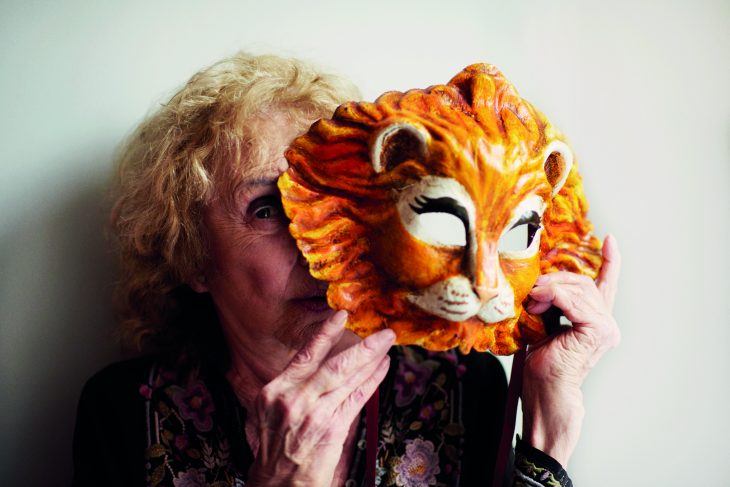
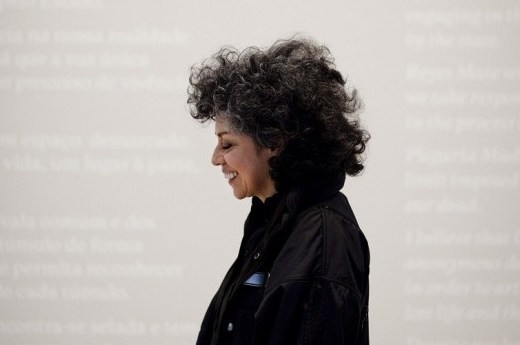
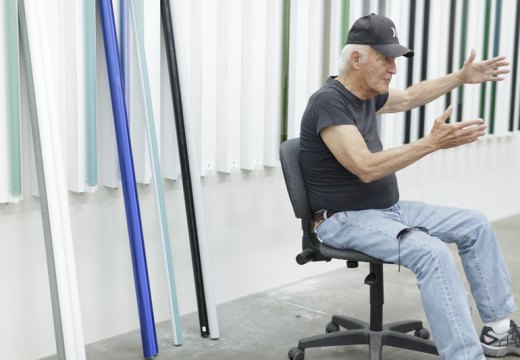
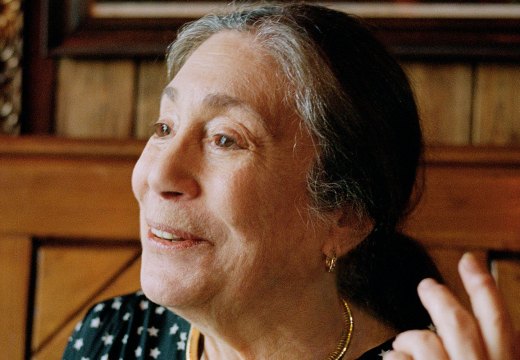









![Masterpiece [Re]discovery 2022. Photo: Ben Fisher Photography, courtesy of Masterpiece London](http://www.apollo-magazine.com/wp-content/uploads/2022/07/MPL2022_4263.jpg)
It’s time for the government of London to return to its rightful home